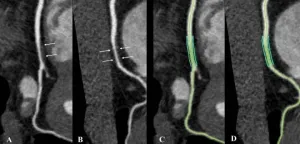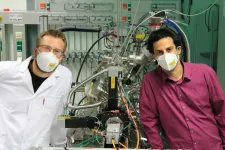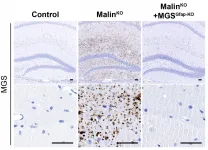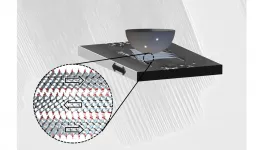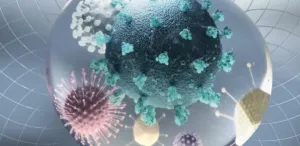(Press-News.org) OAK BROOK, Ill. - People living with human immunodeficiency virus (HIV) and without known cardiovascular disease have two to three times the noncalcified coronary plaque burden of non-HIV healthy volunteers, according to a study from Canada published in Radiology. Researchers said the results underscore the importance of a heart-healthy lifestyle in people living with HIV.
HIV/AIDS emerged as a major public health crisis in the 1980s. Disease-related mortality peaked in the mid-1990s and has been dropping since, thanks in large part to antiretroviral therapy, which does not cure the disease but helps control it.
Today, people with HIV infection live longer and are increasingly subject to age-related diseases, such as coronary artery disease. Studies from North America and Europe have shown a greater risk of heart attacks in people living with HIV compared with the general population, even after adjustment for risk factors. The reasons for this are not entirely known.
For the new prospective study, researchers compared the burden and CT characteristics of coronary plaque in 265 participants, including 181 asymptomatic people living with HIV without known cardiovascular disease and 84 non-HIV healthy volunteers.
All 265 participants underwent coronary artery calcium scoring, a CT-based assessment that provides information on the presence and amount of calcified plaque in the arteries of the heart. Most of the participants also had coronary CT angiography, a noninvasive imaging option capable of quantifying and characterizing coronary plaque and predicting the risk of adverse cardiovascular events like a heart attack. Image assessors who had been blinded to the clinical characteristics of the participants and their HIV status used the CT angiography results to categorize the coronary plaques as calcified, noncalcified or mixed.
There was no difference between the two groups in coronary artery calcium score and overall plaque prevalence. The median 10-year Framingham Risk Score, a commonly used measure to estimate the risk of coronary artery disease, was also similar.
However, noncalcified plaque prevalence and volume were two to three times higher at coronary CT angiography in people living with HIV compared with non-HIV healthy volunteers after adjustment for cardiovascular risk factors. Noncalcified plaque may be more prone to rupture than calcified plaque.
"Our study shows that noncalcified coronary plaque is increased in people living with HIV," said study lead author Carl Chartrand-Lefebvre, M.D., M.Sc., from the Radiology Department at the Centre hospitalier de l'Université de Montréal (CHUM) in Montreal. "And noncalcified plaque has previously been shown to be associated with worse cardiovascular outcomes than calcified or mixed plaques."
Calcified plaque frequency was reduced in people living with HIV. Treatment with protease inhibitors was associated with higher volume of overall and mixed plaque.
According to Dr. Chartrand-Lefebvre, the differences in plaque burden between the two groups are likely due to a number of factors, including the antiretroviral therapy.
"Multiple studies suggest that there is probably an impact of antiretroviral therapy that could increase the risk of coronary artery disease, although there are far more advantages for people living with HIV to be on antiretroviral therapy, instead of not taking it," he said.
The study results suggest that the adoption of a healthy lifestyle, crucial to preventing atherosclerotic disease in the general population, may be especially important for people living with HIV. Dr. Chartrand-Lefebvre recommended that people living with HIV be aware of their cardiovascular risk factors such as smoking, diabetes, high blood pressure, obesity and lack of physical exercise. They should also discuss with their physicians the best ways to prevent cardiovascular disease.
"For radiologists, these results suggest that coronary CT angiography interpretation in people living with HIV should probably include quantification of coronary plaque by subtypes to allow better cardiovascular risk stratification," Dr. Chartrand-Lefebvre said.
INFORMATION:
The new study is nested in the Canadian HIV and Aging Cohort Study (CHACS), a large multicenter initiative based at the CHUM Research Centre. CHACS was implemented in 2012 by Cécile Tremblay, M.D., and is now led by Madeleine Durand, M.D., M.Sc.
"Prevalence and Characterization of Subclinical Coronary Atherosclerotic Plaque with CT among Individuals with HIV: Results from the Canadian HIV and Aging Cohort Study." Collaborating with Drs. Chartrand-Lefebvre, Tremblay and Durand were Irina Boldeanu, B.Sc., Manel Sadouni, M.D., Samer Mansour, M.D., Jean-Guy Baril, M.D., Benoît Trottier, M.D., Gilles Soulez, M.D., M.Sc., Anne S. Chin, M.D., and Jonathon Leipsic, M.D., for the investigators of the Canadian HIV and Aging Cohort Study.
Radiology is edited by David A. Bluemke, M.D., Ph.D., University of Wisconsin School of Medicine and Public Health, Madison, Wisconsin, and owned and published by the Radiological Society of North America, Inc. (https://pubs.rsna.org/journal/radiology)
RSNA is an association of radiologists, radiation oncologists, medical physicists and related scientists promoting excellence in patient care and health care delivery through education, research and technologic innovation. The Society is based in Oak Brook, Illinois. (RSNA.org)
For patient-friendly information on CT angiography, visit RadiologyInfo.org.
Researchers at Beam Therapeutics have developed a redesigned base editor that shows considerable promise in directly repairing the single-base mutation that causes sickle-cell disease (SCD). Many strategies are being pursued to harness genome editing approaches including CRISPR to treat patients with SCD and related hemoglobinopathies. The most advanced method in the clinic involves targeting an upstream regulatory pathway to switch on expression of the fetal hemoglobin gene but does not target the SCD mutation directly.
Writing in the April issue of The CRISPR Journal, a team at Beam Therapeutics, led by Ian Slaymaker and Giuseppe Ciaramella, describe the successful ...
In a study conducted at the University of Helsinki, researchers found a cause for severe epilepsy resulting in death in Parson Russell Terrier puppies at a few months of age. A change in the PITRM1 gene can lead to a dysfunction of mitochondria, the cellular energy pumps. Concurrently, amyloid-β accumulation and widespread neurodegeneration associated with Alzheimer's disease were identified in the puppies' brains. Changes to the PITRM1 gene in humans also cause a severe but slowly progressing brain disease.
Some Parson Russell Terrier puppies were seen to suddenly develop epileptic seizures at 6 to 12 weeks of age. The disease progressed very rapidly, in a matter of hours in the worst cases, to a situation where the seizures were continuous and unresponsive to medication.
"All ...
Exposure to certain endocrine-disrupting chemicals could elevate the risk of breast cancer, according to a new comprehensive systematic review of epidemiological research. However, for many chemicals, evidence is inconsistent or still limited. The review was carried out by researchers at the universities of Hong Kong and Eastern Finland and published in Critical Reviews in Food Science and Nutrition.
Endocrine-disrupting chemicals (EDCs) can interfere with the body's hormonal system, also called the endocrine system, and are widely present in the environment. They originate from a variety of ...
If the CO2 content of the atmosphere is not to increase any further, carbon dioxide must be converted into something else. However, as CO2 is a very stable molecule, this can only be done with the help of special catalysts. The main problem with such catalysts has so far been their lack of stability: after a certain time, many materials lose their catalytic properties.
At TU Wien, research is being conducted on a special class of minerals - the perovskites, which have so far been used for solar cells, as anode materials or electronic components rather than for their catalytic properties. Now scientists at TU Wien have succeeded in producing a special perovskite that is excellently suited as ...
As we accumulate more and more gene-sequencing information, cell-type databases are growing in both size and complexity. There is a need to understand where different types of cells are located in the body, and to map their gene expression patterns into specific locations in tissues and organs. For example, a gene can be actively expressed in one cell while suppressed in another.
One way of mapping genes into tissues is a technique called in situ hybridization. Simply put, a target gene is tagged ("hybridized") with a fluorescent marker within the sections of the tissue it is located in (the "in situ" part). The sections are then visualized under a specialized microscope to see where the gene "lights up". Consecutive photographs of each section are then put together to generate a ...
Lafora disease is an inherited neurodegenerative condition that initially develops with seizures in adolescence and evolves with progressive degeneration of the nervous system to death, about ten years after its onset. It is characterised by the accumulation of abnormal glycogen aggregates called Lafora bodies in the brain. There is currently no treatment for this condition, although some therapies are being tested in clinical trials.
Led by Dr. Joan Guinovart, emeritus professor of the University of Barcelona (UB) and also group leader of CIBERDEM, the Metabolic Engineering lab at IRB Barcelona has discovered that Lafora bodies that accumulate in glial cells, which are essential for the proper ...
You can lubricate a bicycle chain with oil, but what do you do with a Mars rover or a red-hot conveyor belt in the steel industry? Very special nanomaterials have now been studied by the TU Wien together with research groups from Saarbrücken (Germany), Purdue University in the USA and the Universidad de Chile (Santiago, Chile).
The material class of MXenes (pronounced "maxene") has caused quite a stir in recent years in connection with novel battery technologies. But it now turns out that they are also an excellent solid lubricant that is extremely durable and performs its task even under the most difficult conditions. These remarkable properties of MXenes have now been published in the renowned journal ACS Nano.
Like a stack of sheets of paper
Just ...
A new type of COVID-19 testing strategy could help streamline the process of identifying cases, tracking variants and detecting co-infecting viruses.
At present, separate assays and complex workflows are involved in each of these three diagnostic procedures, with analyses typically performed in highly specialized facilities. KAUST researchers have now combined all three kinds of tests into a single procedure that should allow for point-of-care tracking of COVID-19 and the many emerging variants of SARS-CoV-2.
"Our all-in-one test provides a promising integrated solution for rapid field-deployable detection and mutational surveillance of pandemic viruses," says stem cell biologist Mo Li, who led the study.
The test involves a portable ...
Scrobiculariaplana is a type of wedge clam widely found along the coasts and estuariesof northern Europe, the Mediterranean and West Africa. Like other mollusks, it is used as a bioindicator to study pollution in these types of ecosystems, for its ability to accumulate heavy metals and organic pollutants.
A new study has managed to identify the transcriptome and the associated proteome of this bivalve, a finding that could represent an important leap forward in the early detection of pollutants in coastal areas. While the genome is the DNA content comprising the genetic information essential for life, the transcriptome includes only the information on genes that are expressed, while the proteome is the totality of proteins expressed at a given time and under specific conditions. Therefore, ...
Frequent use of social media may not amount to the same as addiction, according to research at the University of Strathclyde.
The study invited 100 participants to locate specific social media apps on a simulated smartphone screen as quickly and accurately as possible, while ignoring other apps. The participants were varied in the extent and type of their social media use and engagement.
The exercise aimed to assess whether social media users who reported the greatest level of use were more likely to have their attention drawn to the apps through a process known as 'attentional bias,' ...
